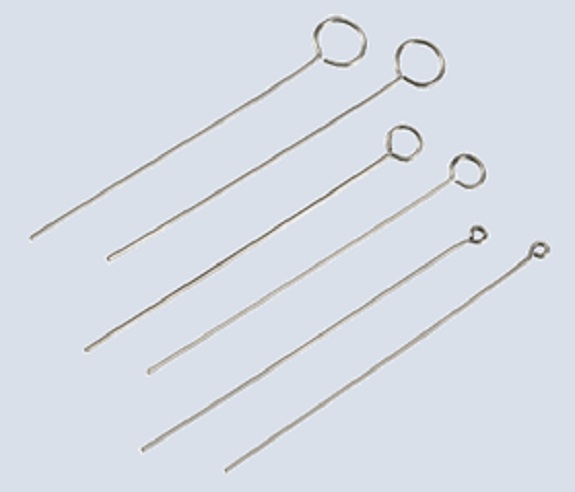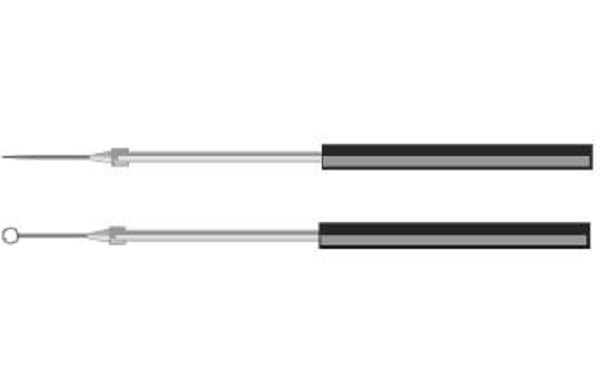Laboratory instruments and materials can receive many classifications, either by their function, by the material of their composition or even by its system. There are some that are used in all types of laboratories, in any work. While there are others that are more specific for one type of studies. Then we will only find those in specialized laboratories. This is the case of the inoculation loop, discover seven of its main uses and its function within the laboratory.
What is an inoculation loop ? 🔬🦠
Also known as inoculating loop, bacteriological loop or platinum handle, is a tool formed of nichrome wire, platinum or tungsten. Whose end has the shape of a loop with a diameter of between 1 to 5mm. It is used in inoculations of microbiological cultures in different techniques such as smearing, scratching or needling.
Called in some places Kolle's asa because of its creator Wilhelm Kolle this laboratory instrument has a base or handle. Which can be made of the same material of its end or also of aluminum and steel. The the most common design is that its end culminates in a loop or arito, but there are others where it ends in a spike.


Features of the inoculation loop
Kolle handles have a fairly simple structure but make it work perfectly for the job you do. They consist of two extremes that we will describe below:
Handle or base:
It is the part of the loop that serves for its manipulation, it is usually constructed of metal coated by an insulator for heat. In this way, the operator is prevented from having burns when sterilizing the end of it. Its approximate measurement is 20 centimeters although there are larger specimens.
Handle or loop:
This is the functional part of the element in question, it is that is the part that comes into constant contact with the microorganisms of work. Either in culture media, agars, stock solutions or biological liquids. It is formed by a thin wire whose structural material it can vary.
This section is approximately 6.5 centimeters long and may or not being calibrated. If it is the case of being a calibrated instrument then it has a range between 0.1 to 1mm. In total the complete handle can measure about of the 27 centimeters, although this is quite variable depending on the house manufacturer.
Types of bacteriological asa
The classification of this instrument is given due to the specific function that each of them can fulfill. More specifically it classified according to the characteristics of their end, we will describe them to continued:
Non-calibrated ring shape: It is the most used type within microbiological laboratories. It is used to take inocula from any type of medium (liquid or solid) for sowing in another culture medium. In addition, it is also used to perform microbe spreads on an object carrier. It has been designed so that it glides smoothly on the agar. Many sowing techniques can be carried out in a simple way, as long as the personnel are qualified for it.
Calibrated ring shape: This type of loop as indicated by its name ends in a ring that has been calibrated. In this form it takes a specific amount of microbial suspension. Its use is quite common in the realization of urine cultures where it is sought to quantify the colony-forming units (CFU). Like any calibrated material, the bacteriological loop has a certain margin of error. It will depend on the cohesive forces and surface tension, varying according to the sampling angle and the size of the sample container.
In addition there are
In needle or straight: Also known as handle in thread, is one that has a straight end. It is used for inoculation of biochemical tests by using the puncture technique. It is also used in sub crops of specific colonies, always at the decision of the trained bacteriologist.Spatulate: It is used to cultivate microorganisms that form dry and hard colonies such as mico bacteria. Be basically the use of its spatulate form to be able to take portion of the colony.L-shape: It is used in the cultivation mycological, since its shape allows to take with great precision the structures to replicate. It is especially used with molds.


In addition to this classification given by its form, there is another classification according to their time of use. There are those for permanent use which are those made of metals capable of being sterilized by warming. Which if they are given proper use and maintenance they have great durability. On the other hand you will find the disposable handles that they are usually made of plastic. They come sterile from the factory, ready for be used only once and discarded later.
Using the inoculation loop 🌡
This laboratory-specific tool bacteriological it is used to drag, transfer and transport inocula of small volume.
From a stock solution to a suitable culture medium.
In addition to this it is also used for the realization of microbial smears or spreads. In some cases it is used to take direct sample from mucous membranes or fluids.
Its use may seem simple, but it really is required a lot of training and knowledge of specific techniques for its correct use in a sowing.
Sterilization of the platinum handle
This is a fundamental part of the use and care of the inoculation loop, since the correct reproduction of microorganisms depends on this step. To perform sterilization, the handle must be placed at the top of the flame. Preferably using a Bunsen or Meker lighter. It should be positioned as vertically as possible to ensure the sterilization of the ring and much of the end. Once the filament turns red, it can be assumed that the handle has been sterilized.
Now that you have known the seven uses of the inoculation loop you can understand that although certain instruments are not commonly used. It does not make them unimportant, but rather that each one adapts to the work needs in each area they perform. Do not forget to go through other of our publications so that you know much more information about laboratory materials.

